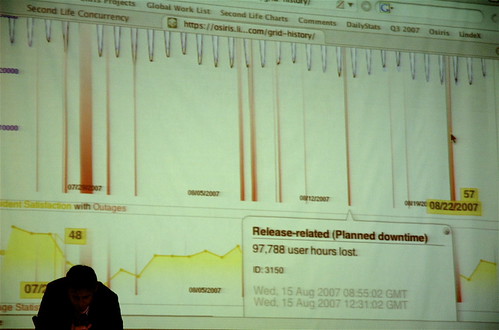CC Chapman, Mike Coulson of Crayon and Mike Donnelly of Coca Cola did this presentation together in which they talked about their project “Virtual Thirst“. In the first part they explained the process behind it and in the second part Mike Donnelly got into all those myths cerated by this Wired article.
The Virtual Thirst campaign basically consisted of 3 phases. Phase 1 was about listening to people. Crayon and Coke created a focus group/advisory panel of a bunch of community experts and discussed ideas with them. They are after all the ones who know how to approach a specific audience (although Crayon actually also does know that quite well IMHO).
Phase 2 was about getting the project started. Britney Mason was e.g. looking for builders to build prototypes of vending machines. Coke also rented a temporary space from Crayon because it was meant as a temporary project with a beginning and an end. A separate sim wouldn’t have made sense according to Mike Donnelly.
In this phase they also made it easy to participate by providing quite a bunch of different ways to do so.
Phase 3 was about celebrating the creativity. This phase is where we at right now. The winner is known and the final product is being created right now by the people of Millions of Us. With that comes a virtual launch party and the goal is to let the winning product spread virally by providing free copies.
Mike also talked about how they gauged success. First of all there is of course the number of entries (which he did not really tell us unfortunately), then there is also the reactions and responses of the community. As they said in an earlier panel they also researched the tone in which articles have been written. Moreover he stated the following facts;
- 300 blog posts about the contest
- 33,000 links
- 150+ photos in Flickr
- 31,000 Youtube views with 160,000+ comments
Another thing they did was the Second Life movie premiere of the Happiness Factory Movie. This was done in collaboration with Rivers Run Red. This again is a project with a defined lifetime and thus only temporary space is used again.
He then talked about their marketing plan to be integrated. They use online as well as offline media and all this around the world. Which brought him to talk a bit about the recent Wired article in which Wired claims that their campaign wasn’t a success. He said the contrary and answered some of the claims Wired did. Thus there haven’t been millions spent on that project, Coke is not pulling out but instead this is just the beginning (and it was supposed to be a timely limited project). Moreover they had a full series of events and altogether that was a total new media approach to Coke. All in all it wasn’t about selling cans of soda but instead about branding and experience. And this is something you cannot really measure (but this is true with offline projects like this, too).
Now there has been some criticism of these statements in the blogosphere which started with Tony Walsh’s article that it might not have been such a big success as stated. He especially mentions:
- 175 MySpace friends with 13 comments.
- 26 subscribers to the Virtual Thirst YouTube video channel with 12 videos and 2,589 channel views. Most of the videos appear to be created by Crayon, not contestants.
- How many entries were received?
Now this is probably something to debate further and I’d really would like to see Mike Donnelly come in-world again to carry this discussion on. But all in all I think that however you look at it this is still a great example of how to do a campaign in Second Life. It also is a great sign of a big brand that experimentation is key. I am not sure that one can expect complete success with the first try on that. It will be interesting to see what will follow it.
At the end of his talk Mike was also giving a list of lessons learned, which are:
- Listen and communicate with the community, not at them
- Partner with pros (in this case Crayon and RRR)
- SL is community driven, not location driven, people are more improtant than prims
- Success is organic: Flexi = good
- Embrace Critics and Learn from them
- Max. success by using multiple channels: Don’t ignore RL
- Strike a Balance between Art & Science
He again stated that this was a huge success for Coke. One might say that this is easy to say for a field in which you cannot really measure success but nevertheless I think that other companies can learn a lot from esp. these lesson where I actually would add another one:
- Experiments are king
(oh, and open it up for german residents to also be able to attend next time 🙂 )
Tags: crayon, coke, newmedia, slcc2007, slcc, chicago, taotakashi

















Recent Comments